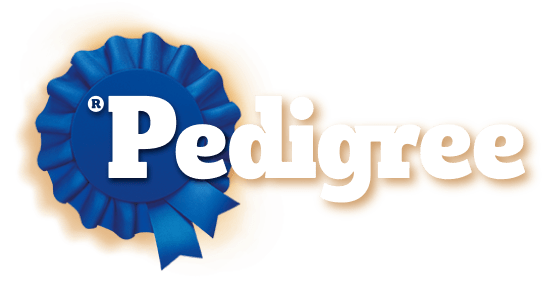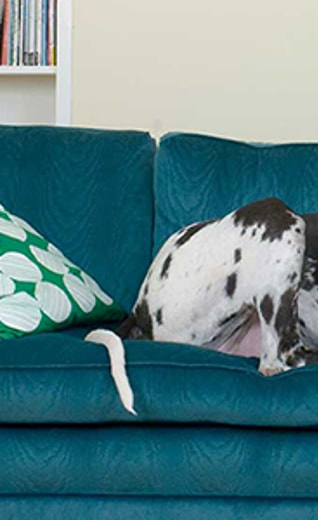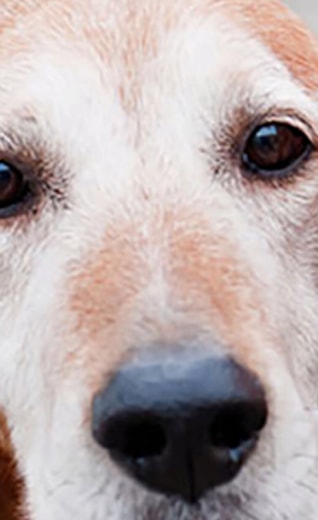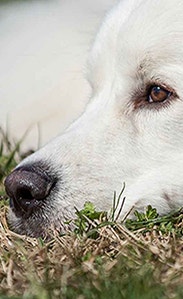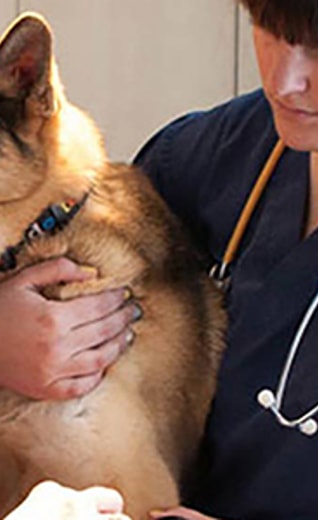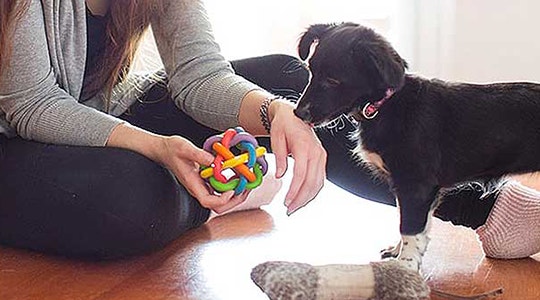
8 Fun Indoor Activities for Dogs
Looking for ways to entertain your bored or antsy pooch when you’re both inside? Try these eight great ways to keep your pup physically active and mentally stimulated when you can’t make it outdoors.
![]()
Get Your Dog Moving
1. Hide and Seek
Almost every dog we know loves to play this classic game. If your pooch has mastered the “stay” command, get them to wait in one room while you hide in another spot in your home with treats. Then call them from your perfect hiding spot and let them come find you. When your dog does, give them lots of praise and a delicious reward — we like to break up whole DENTASTIX™ treats into smaller pieces.
2. Stair Sprints
Want to burn some of your dog’s pent-up energy while you sneak in a little exercise, too? Take the stairs! Have your dog run up and down with you three times. Then catch your breath and repeat. It’s a great way to have fun together and get your hearts pumping. (If you don’t have stairs, no problem. Just run up and down a long hallway instead!)
3. Indoor Obstacle Course
Turn your living or family room into an agility course for your pup! You can include jumping, weaving and tunnel obstacles, and tailor each one to your dog’s size. For jumping obstacles, use couch cushions or a broomstick on top of two laundry baskets. Create a weaving obstacle by spacing out paper towel rolls evenly in a straight line. For a makeshift tunnel, you can use a collapsible kids’ play tunnel or create your own with chairs and blankets. Once your course is ready to go, use verbal commands or hand gestures to guide your dog through. Oh, and be sure to give them lots of praise when they finish the course!
4. Tug of War
Studies have shown that playing tug can help your dog feel more confident; it doesn’t make them more aggressive and can actually strengthen your trust bond. Talk about a win-win-win!
Playing tug of war with your dog is a great way to fit in quality one-on-one time: Your pup gets your undivided attention and burns off a little energy, too. We recommend having a dedicated “tug” toy that’s the right size for your dog. And to protect your dog’s spine, always shake the toy from side to side rather than up and down.
5. Treasure Hunt
This game is so simple. Just put your dog in a room or their crate while you hide tasty treats or kibble around your house. (You can also use their favorite toys if you’re watching your pup’s waistline.) Once you’ve hidden all the treats, turn your dog loose, guiding them as needed. They’ll have a blast sniffing them out.
![]()
Get Your Dog Thinking
6. Basic Obedience Training
If you’re staying indoors, it’s a good opportunity to work on basic commands like “sit,” “stay,” “lay down” or “shake.” Basic obedience training combined with positive reinforcement encourages your dog to think and focus, which is excellent for their mental health. It’s also a great way to connect with your dog and make sure their basic commands don’t get rusty.
7. Treat Puzzles and Feeders
Interactive food toys encourage your dog to use their powerful noses, natural foraging instincts and problem-solving skills. They can also help your dog feel less bored, stressed and anxious. Plus, they slow down your dog’s eating — which is great if they usually gulp down their food!
8. New Tricks
Who says your adorable dog can’t learn new tricks? Not us! If your dog already knows how to “go get it” and “drop it,” step up your game and teach them how to put away their own toys.
To help your dog learn this convenient new trick, give them a toy and put a dedicated storage basket very close to them. Once they pick up their toy, lure their head over the basket and ask them to “drop it.” Every time they do, reward them with lots of praise or maybe even a treat.
Once they master this step, gradually move the basket farther away and use verbal commands like “clean up your toys” to cue the trick. Your dog will enjoy learning something new, and you’ll appreciate the help tidying up around the house.
